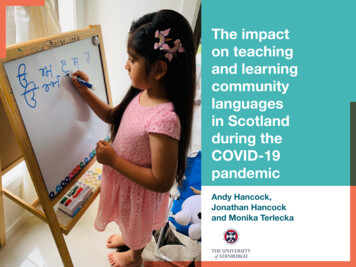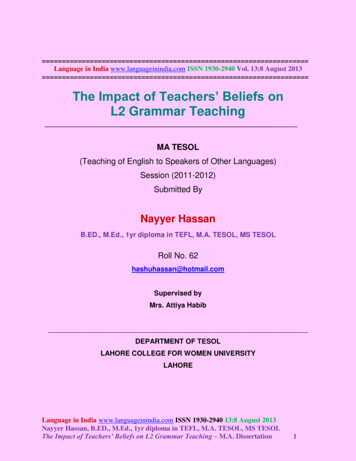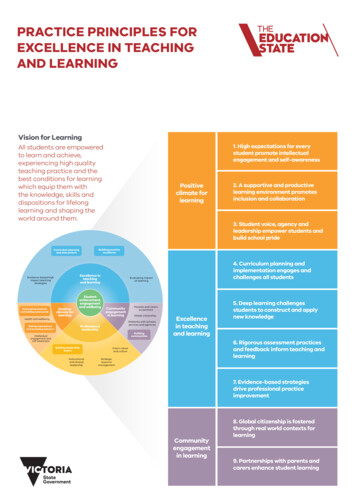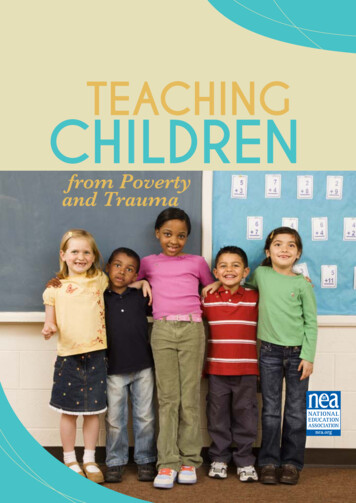
Transcription
The impacton teachingand learningcommunitylanguagesin Scotlandduring theCOVID-19pandemicAndy Hancock,Jonathan Hancockand Monika Terlecka
ContentsExecutive Summary 1Data sources 2Key findings 3Conclusions and recommendations41.Introduction 62.Key findings 8Transition to remote learning and teaching8Challenges of remote teaching and learning15Benefits of remote teaching19Future changes to teaching and learning23Future challenges 253.Discussion and recommendations26References 29
Executive summaryAs part of the Scottish Government’s response to the COVID-19 pandemic,all local authority schools closed from 20 March 2020. As schools adapted todelivering remote learning and teaching, so too did complementary schools,teaching community languages to a significant number of children and youngpeople in the evenings and at the weekend. This report adds to a growingresearch base on the impact of remote teaching and learning on school-agedpupils during the pandemic but also sheds light on important learning outsideof mainstream school provision, which often goes unnoticed. We describe thetransition to remote learning and teaching; the choice of digital tools used foreffective learning at home; learner engagement before and after lockdown; thechallenges faced, and any benefits of the interim solutions initiated to meet theneeds of multilingual learners.Page 1
Data sourcesThe report is based on national data gathered from an online questionnaire andinterviews with representatives of complementary schools. Data was collectedfrom September to December 2020 in order to capture evidence about remotelearning and teaching during the first lockdown. Questionnaires were returnedfrom 34 complementary schools representing 19 different community languages(Arabic, Mandarin, Cantonese, Urdu, Polish, German, Italian, Portuguese,Russian, Bengali, Danish, Dutch, French, Hebrew, Hungarian, Japanese,Lithuanian, Punjabi, Spanish). Interviews were conducted with 13 participantscovering 11 community languages (Mandarin, Cantonese, Polish, Japanese,German, Hungarian, Hebrew, Dutch, Italian, Russian, Arabic). Capturing theexperiences of complementary schools during lockdown will provide insightsinto the capricious nature of complementary schools and help inform how theteaching of community languages can be supported more effectively in thefuture within the context of Scotland’s national 1 2 Language Strategy.Page 2
Key findingsmajority of schools consulted with teachers and parents Theon decisions about how to teach during the pandemic but mostschools did not consult with their learners. It emerged from theresearch that there is scope for schools to explore further opportunities forconsulting with learners on a range of school-related matters, and create All schools sought to ensure the pupils’ learning would continue1spaces for learners to take ownership of their learning. Though the particularat home, with a range of solutions implemented includingexperimenting with a range of tools and finding new ways toengage learners. The majority of schools delivered real-time online lessonscircumstances and size of schools may impact on the nature of theseat the usual time but some schools also investigated ways to encouragemajority of schools reported that they did not find the move Theto remote learning and teaching easy.independent learning. Schools drew on the expertise within their own schoolcommunity to support the transition to remote learning and teaching and someopportunities, it is vital that learner agency is prioritised especially in the contextof lockdown.Challenges included teachers’schools searched for new online resources from their heritage country.unfamiliarity with new ways of working, interacting effectively with pupils onlineand a home environment not conducive for study. Although schools attempted Almost three-quarters of schools witnessed a drop-off into incorporate cultural elements into their lessons, a vast array of cultural andlearner engagement. The schools reported that the reducedengagement was more acute amongst the younger age group.physical activities were no longer offered because of lockdown restrictionsIn general, lessons during lockdown were shorter, with schools attributingpeople’s physical wellbeing.the reduction in lesson times and drop-off in engagement to several factors,including demands on parents’ time, the learners finding it difficult to focus,and parents looking to limit the amount of time their children spent in front ofand school site closures. This could have an impact on children’s and youngmajority of schools believed the pandemic offered benefits Theand new opportunities for teaching community languages.a screen.Although the schools reported that the challenges of remote learning andteaching outweighed the benefits, the participants noted a number of benefitssuch as new ways of teaching, more effective parental engagement and beingable to reach new pupils from a wider geographical area.1 Hungarian playgroup closed during lockdown but resumed online at the beginning of the academic year. The Urdu school had closed at the beginningof the pandemic because the local authority would no longer fund the teacher’s salary.Page 3
Conclusions and recommendationsThis research has provided an in-depth analysis of the impact on teachingnew and creative ways of working in the future in order to reach new learners.and learning community languages in Scotland in the face of the COVID-19Language learning provision can also be extended to include different modelspandemic. It has revealed a committed and concerned group of teachers, whoof provision including learning community languages in mainstream schoolswere interested in changing practice and delivering teaching in new ways inusing virtual learning environments.challenging circumstances.We recommend that the ScottishWe recommend that the 1 2 LanguageGovernment in collaboration with localStrategy Implementation Group investigatesauthorities should consider differentdifferent models of provision includingfunding options to complementary schoolsbuilding on lessons learned about remoteand establish partnership agreements thatteaching and mainstreaming communitysupport their longer-term viability.languages in order to re-engage learners.A number of factors including a loss of revenue from tuition fees, teacherThe drop off in learner engagement raises concerns about the consequencesretention, local authority budget cuts and Brexit have impacted seriously on theof the short-and longer-term loss of community language skills, particularlyviability of some schools. Building respectful partnerships with local authoritiesamongst the younger age groups. Complementary schools know their learnersand mainstream schools will allow complementary schools to establish effectiveand families well and provide an important social and cultural service to theirnetworks to share and reflect on what works well and access a wide rangecommunities. Therefore, the school can build on what they have learned aboutof professional learning opportunities to support the quality of teaching andremote teaching and learning and use the experience to develop and implementlearning.Page 4
We recommend that further researchis essential to gain insights into theexperiences and perspectives of families,particularly the learners themselves, and toassess the full impact of the pandemic oncommunity language learners’ educationalattainment, multilingual skills and lifechances.This report has offered insights into the perspectives of school representativessuch as headteachers, board members and teachers. Although theserepresentatives are likely to be also parents, it is vital that other perspectivesare heard to achieve a comprehensive and detailed account of the after-effectsof school closures to help inform measures that can be put in place to sustainlearner engagement and support community language learning. There isparticular scope for schools to consult more closely with learners, and furtherdevelop opportunities for pupil-led learning in complementary school settings.Page 5
1.IntroductionAs a result of the COVID-19 pandemic and ‘lockdown’ measures implementedScottish Government, 2021). Furthermore, this disadvantage is likely to bein March 2020, mainstream schools in Scotland were rapidly forced to changemore prevalent amongst black and minority ethnic groups (Assan and Hemady,teaching methods as an alternative to face-to-face classroom teaching and2020).learning. The same can be said about complementary schools (also known ascommunity or heritage language schools) which operated in the evenings andThis research project was initiated to explore the impact of the suddenat the weekend pre-pandemic. These part-time schools, initiated and organizedchanges to teaching and learning community languages in Scotland as aby volunteer parents, play a key role in supporting the linguistic, cultural andresult of an extended period of school closure. Although mainstream schoolssometimes faith education of a significant number of multilingual children andreturned to elements of face-to-face teaching in Scotland between Augustyoung people. Little is known about this type of educational provision outsideand December 2020, complementary school sites remained closed becauseof their own language communities but previous research has highlighted theof access restrictions to mainstream school premises and community centres.many challenges faced by complementary schools such as unsustainableThe research also aimed to gather information about the transition to remotefunding, lack of professional development for teachers and limited access toteaching; the choice of digital tools used for effective learning at home; learnertechnological resources (Hancock & Hancock, 2018).engagement before and after lockdown; the challenges faced, and any benefitsof the temporary solutions initiated to meet the needs of multilingual learners.The transition to emergency remote learning and teaching has also highlightedDocumenting the experiences of complementary schools during the COVID-19concerns about the preparedness of all (schools, teachers, families andpandemic can shed light on aspects of school leadership, the values andlearners themselves) for effective teaching and learning online (Bond, 2020;purposes of the schools, and help inform how the teaching of communityEducation Scotland, 2021; Lucas et al., 2020; OECD, 2020). Studies fromlanguages can be supported in the future within the context of Scotland’sScotland have also highlighted how school closures have exacerbated thenational 1 2 Language Strategy (Scottish Government, 2012). Although theexisting inequalities in our education system presenting significant challengesresearch is focused on the first lockdown, the findings are applicable to currentto disadvantaged pupils who may not have access to digital devices and aand future planning in relation to complementary schools and communityconducive home environment for study (Child Poverty Action Group, 2020;language provision.Page 6
The findings in this report are based on two interrelated data sets. A 24-itemThe questionnaire also included a space at the end where the participantsquestionnaire, generated by the Bristol Online Survey (BOS) tool was distributedcould write down their contact details if they wanted to contribute furtherby email to 94 complementary schools in Scotland, using an updated databaseto the project by doing an online interview. As a result, 13 follow-up onlineof provision from a previous research study (Hancock & Hancock, 2018). Theinterviews were conducted covering 11 different languages (Mandarin n 2,diversity and unstable nature of the sector means some complementary schoolsPolish n 2, Cantonese n 1, Japanese n 1, German n 1, Hungarian n 1,move in and out of existence because of a lack of available teachers andHebrew n 1, Dutch n 1, Italian n 1, Russian n 1, Arabic n 1). The semi-restricted funding. Also, some organisations are just a small group of parentsstructured interviews were framed from a collection of topics covered in theand children meeting in community premises or private houses and thereforequestionnaire to provide reasonable consistency across a range of interviews,not officially identified as community language schools. Furthermore, it iswhilst remaining loose enough to allow for a free-flowing conversation tosometimes difficult to identify if religious settings, such as Mosques, Gurdwarascapture individual variation.and Synagogues, provide language as well as faith teaching.A pilot of the questionnaire was sent to two separate complementary schoolsto gain feedback on the design and amendments made. Questionnaires werereturned from 34 complementary schools (36% response rate) representing 19different languages (Arabic, Mandarin, Cantonese, Urdu, Polish, German, Italian,Portuguese, Russian, Bengali, Danish, Dutch, French, Hebrew, Hungarian,Japanese, Lithuanian, Punjabi, Spanish). Two thirds of the languages wererepresented by more than one school, with Mandarin being the most common(n 7), followed by Arabic (n 6), Urdu (n 5), and Polish (n 5). Six schools fromthe survey teach more than one language - Mandarin and Cantonese classes(n 3), Arabic and Urdu (n 2), and one school provides classes of nine differentlanguages.Page 7
2. Key FindingsTransition to remote learning and teachingAll schools sought to ensure the pupils’ learning would continue at home, usingOne teacher was trained in online pedagogy and helped train the other teachers usinga range of solutions. Some schools moved to remote teaching earlier thanZoom but using kinesthetic special activities so we can improve contact with youngothers because of a heightened awareness of lockdown measures in otherchildren. The teachers meet every week and we exchange ideas. (Russian School)countries.One member of the Board of Trustees is a teacher in a mainstream school and she hasCovid started in January and many families travelled to China for the Chinese Newdone professional training on online learning. (Mandarin Chinese School)Year, so we cancelled the New Year Gala at the beginning of February and alreadymoved to online because parents were anxious [about being in the school]. (MandarinThe teachers also have other jobs so it takes time to set up anything new. [At the beginningChinese School)of lockdown] volunteers from the [local University] set up the Zoom platform and thestudents did the PowerPoints and students sat in on classes as assistants. The teachersWe share the same school as the Chinese school who stopped live classes before us, so wesaid the PowerPoints were high quality. But then student volunteers went home.started looking at tools in Italy. When the school closed we looked at alternatives because(Cantonese/Mandarin School)Italy was already in lockdown so we were prepared. (Italian School)IB [International Baccalaureate] allows opportunity for a mother tongue for a sixthA number of schools were able to draw on their own expertise and knowledgesubject so I teach Dutch for IB all over the world so I am used to doing it online usingof people within the school community to support the transition to remoteSkype every week. But the internet can be bad in some countries. (Dutch School)teaching.Page 8
Some schools reported that they developed ‘self-help’ guides for parents andSchools were asked what tools they used for learning and teaching. Zoomlearners.proved to be the most widespread tool (71%), followed by Google Classroom(22.6%), Skype (19.4%) and MS Teams (16.1%). Other methods includedWe provided training to the teachers and detailed guidance to students and parents. WeWhatsApp (n 3), DingTalk (n 2), Portuguese platform (n 1) and Go To Trainingalso supported parents facing technical issues. (Portuguese School)(n 1). Tools with no cost were an important consideration for the schools.At the beginning we had a lot of questions from parents. It was quite intense, we probablyThe transition went smoothly. We closed doors on 14 March a week before lockdown.needed a helpdesk. Parents can find it quite daunting. We put a guide for parents and[Online learning] was already on our ‘to do’ list and introduced in stages. So I alreadychildren on our website with instructions for streaming classes online. (Italian School)had a fair insight into how it could be done. Zoom seemed to be the best platform.(Private Languages School)Microsoft Teams16.1% [5]Skype19.4% [6]Google Classroom22.6% [7]Other32.3% [10]Zoom71%0%10%Figure 1.20%30% 40%50%60%70%[22]80%Platforms used for online teaching and learning.Page 9
We relied on people having their own hardware and subscribed to Google Suite forZoom cuts out. I tried Jitsi platform last time. I will try one more next week and decideeducation, which is free. (Italian School)on the best platform. (Hungarian School)A number of the schools adopted an trial and error approach, and some usedIt was down to me. I use email, WhatsApp, Zoom and Skype to stay in touch with thea mixture of different online learning tools.students. (Dutch School)I looked at three tools and went to Google Suite. It is free and very good to organiseSeveral schools explored opportunities to supplement the online learningteachers and homework. When we started using [it] there were improvements in Googlelessons through physical materials and other resources.Classroom by providers as more people were using the platform. We also looked atMicrosoft but it is not convenient or well structured. I looked at Zoom but there areWe sent physical packages of learning and craft materials to be used during Zoomproblems with security. This is what drove us to Google. (Italian School)sessions. (Hebrew School)Community schools do not have a lot of assets. We had to use free software and a platformwith no support so it is hard for teachers. DingTalk2 like MS Teams is free and popularWe share information and homework on Facebook. We created private groups for thein China as schools moved to online teaching [in China]. We can do more remote teachinginformation. Visual educational online learning: songs, pictures, stories, quizzes online.together and can share homework. There is a lot of functionality but designed for(Lithuanian School)parents. We continue working from the same book, but we also added a lot of differentChina so sometimes there are network problems. I hadn’t heard of DingTalk before thepandemic, now we use a mix of Zoom and DingTalk. (Mandarin Chinese School)We used our Facebook closed group to offer ideas for parents. Songs, nursery rhymes,children’s stories were shared. (Hungarian School)We decided to use Zoom for online teaching but at the same time we needed a teachingplatform. We chose Google Classroom because it doesn’t cost money, we didn’t know whatit was like but used it to help children and parents with homework. You can uploadchildren’s work. ( Japanese School)2 DingTalk is an enterprise communication and collaboration platform based in Hangzhou, China. It was founded in 2014 and by 2018 was one of theworld’s largest professional communication and management mobile apps with over 100 million users.Page 10
A few schools reported that they accessed online resources from their heritageWe read little stories like what the children in Israel learn. It was a pick and mixcountry.approach. I am quite comfortable choosing my own stuff. Before we used workbooksbut there is loads of free stuff on the internet from Israel. I use a programme from IsraelOnline platform developed by Portuguese publishers and supported by the Portuguesefor children having difficulty with literacy. (Hebrew School)Government (‘Escola Virtual’). (Portuguese School)Schools were asked what methods they used to provide learning to pupilsThe Chinese Government helped the teaching of Chinese around the world through theat home. The majority of schools (71.9%) delivered online lessons live at theGovernment backed Global Chinese Learning Platform. Videos are available and helpusual time with just under half (46.9%) providing learning offline. Ten schoolswith how to keep children’s attention. (Mandarin Chinese School)also responded that they delivered live online lessons but at a different timecompared to pre-pandemic times. Other methods included Padlets (n 1),Portuguese platform (n 1), WeChat (n 1) and WhatsApp (n 1).Other21.9%[7]28.1%Social media (e.g. FaceBook)31.3%Real-time/live online lessons at a different timeOffline provision such as worksheets/recorded video/[9][10]46.9%written instructions were sent out (e.g. by email)[15]Real-time live online lessons at usual time71.9%0%10%Figure 2.20%30% 40%50%60%70%[23]80%Methods used to provide learning at home.Page 11
School closures in March brought new challenges for complementary schools, theIt started as an personal initiative of one teacher, but later we consulted all teachers andmost important one being the new ways of delivering teaching via online sources.parents via conversations and a survey. (Hebrew School)Schools were asked who was consulted about the teaching methods during thepandemic. Almost three-quarters of schools (74%) consulted with teachers, just overWe asked parents and teachers if they want to use [the Global Chinese Learninghalf (53%) consulted with parents but only six schools consulted with the learnersPlatform] as a main resource as it will save us a lot of time. Some Chinese schools inthemselves.the UK use the Chinese resource as the main resource. The advantage is it is moreprofessional but they don’t know our kids. We know them individually. It’s like givingThe school is run by a parent committee. It made the decision after consulting withlectures to hundreds of people but you don’t know them. Our teachers know them veryteachers and parents. (German school)well. [Our School] decided to use it as a supplementary resource. (Mandarin ChineseSchool)9%Nobody / school closed9%School community18%Students29%School board / management / administration53%Parents74%Teachers0%10%Figure 3.20%30%40%50%60%70%80%Consulting about the teaching during the pandemic.Page 12
The teachers were not asked [about online tools]. We couldn’t go into the [venue] so weThe drop-off in engagement was attributed to several factors, including thehad no other choice but to cancel lessons. ( Japanese School)learners finding it difficult to focus, and parents looking to limit the amount oftime their children spent in front of a screen. This lack of engagement was alsoNearly three-quarters of the schools indicated that there had been a drop-offmore acute amongst the younger age group of learners.in pupils engaging in lessons during lockdown.Engagement depends on the age of the children. We lost a lot of children from the20% less than face to face lessons. (Cantonese/Mandarin School)Cantonese classes. Parents don’t want more on screen learning at the weekend as theydo enough during the week, so we cancelled the youngest class. Children older thanAt the moment, the lessons take place online. Unfortunately, half of the children stop10-years are not too bothered about screen time so we just continued. (Cantonese/learning Lithuanian. (Lithuanian School)Mandarin School)Figure 4.73%Yes15%No6%School was closed / NA3%Unsure3%Only at the beginningDrop-off in pupils engaging in lessons.Page 13
There has been a big drop in pre-school and P1 and P2. Those still enrolled don’tAfter the first hurdle they engaged well but we reduced lessons to one hour as importantparticipate as regularly as the parents now have to spend one hour with their children.for dialogue and language learning. (Italian School)There has been a 50% drop off. (Mandarin Chinese School)We are trying to reduce lesson time. First have 40- minute lesson then take a break andThe young classes stopped. Teenagers are able to do it on their own. Three-year oldsthen do homework. (Cantonese/Mandarin School)can’t sit for quite so long in front of the screen. (Russian School)We used to do 40-minute lessons and reduced to 30 minutes. (German School)Yes, as especially for children with additional support and young age found it difficultto stay on the task. (Urdu/Arabic School)Some schools commented that the external pressures associated with thepandemic, and the demands placed on teachers, parents and learners, hadSchools were asked how much time was spent on lessons before and afterled to a reduction in lesson times.the lockdown. In general, lessons during lockdown were shorter; the numberof schools teaching lessons of less than two hours increased from 15 to 19,All of the board members are voluntary. To re-organise and switch to online was a hugewhile those teaching lessons of more than two hours reduced from 18 to 13.challenge. Pupil participation was high throughout (we cancelled the fees for the lastterm, which may have helped). Continuing online is representing another challenge asWe now have a concentrated 40-minute lesson. It was one and a half hours beforestudents have now started to drop out. (Portuguese School)lockdown including play. The main goal was to keep the kids in contact with each other.(Hebrew School)Some students left because of the pandemic, people feel it is too much. ( Japanese School)Page 14
Challenges of remote teachingand learningFigure 5. shows that most schools (63.6%) ‘strongly disagree’ or ‘disagree’ thatTeachers didn’t see [remote learning] as additional work. They still have to prepareit has been easy to support pupils with quality teaching and learning duringclasses and nobody complained. However, some struggled at first with online tools.the pandemic. In the interviews the school representatives expanded on the(Italian School)reasons behind these views. Their responses covered a wide range of issuessuch as lack of teacher confidence and unfamiliarity with remote teaching,One teacher had a meltdown because Zoom didn’t work, she had to ask parents to returnbarriers to learning and teaching online and an unconducive environment atto the lesson and log on again, it feels like a hassle. (Cantonese/Mandarin School)home for study.12.1%[4]Strongly disagree51.5%[17]Disagree21.2%[7]Neither agree or disagree15.2%[5]Agree0%[0]Strongly agreeFigure 5.Do you agree: It has been easy to support pupils with qualityteaching and learning at home during the pandemic.Page 15
Some teachers who have been teaching for decades said they didn’t want to do onlineIt is big, big work for parents. Previously I met parents often but now I just look at the[teaching]. We are looking at ways of providing training. Notifying parents byscreen. (Russian School)email before lesson and using email for communication is a hurdle for some teachers.(Cantonese/Mandarin School)In class I can see their writing but now it is submitted. I am not sure how much is theirown work or help from their parents so it is difficult to assess their writing. ( JapaneseAlthough parents don’t have to travel to [School] and the lessons are shorter, the teacherSchool)workload is more. Normally [teachers]check homework during breaktime but it is moretime-consuming checking homework online. ( Japanese School)A common theme noted by the schools was children and young people nothaving a conducive home environment to study.Assessing children’s and young people’s learning and progress was also asignificant challenge. Several schools highlighted the importance of parentalThere are several families with laptop and internet problems or noise at home. (Russianengagement, in the sense that young children needed the help of their parentsSchool)to engage with the technology and to participate online.Because of online learning some families have three siblings and families may not haveYou don’t see the body language, online teachers see only a small picture or a small video.more than one device. We had to make a complicated timetable. ( Japanese School)Another challenge for older children is they start chatting to each other, sending messagesto each other. It is not appropriate. You need to tell the teacher to remind them of rules ofSome families have three or four children and not enough devices or rooms. They justonline teaching and remind parents. (Cantonese/Mandarin School)use the phone. (Mandarin Chinese School)The main change was I looked into quizzes to make it more exciting. It is more difficultfor students to do things together, they don’t find it easy to speak up online. (DutchSchool)Page 16
A lot of parents are working in the caring profession, it is not well paid, on the minimumwage and living in short term tenancies with poor connectivity. (Polish School)Schools were asked what cultural related activities they were no longer ableto provide because of closures to school premises.3 The list of activities wasvery extensive and wide ranging but the most popular were associated withParents have lost interest a bit - I can hear them in the background on a work phoneexpressive arts such as dance (n 8), crafts and drawing (n 7), music andcall. (Dutch School)musical instrument (n 6) and sport (n 4). Some of the activities were linkedto cultural interests such as a chess club (Russian school), calligraphy andIt is difficult for parents, some are professionals but others work long hours in hospitality.poetry (Chinese school) and faith practices (prayers). Cultural activities thatSome parents do not have the time. Every day they are given a task to do, but we can’trevolved around festivals and traditions such as Chinese New Year and Eid al-enforce because all families are different. (Mandarin Chinese School)Fitr were cancelled. Furthermore, social events such as graduation ceremoniesand new academic year celebrations were called off. It is quite clear that thepandemic brought a narrowi
of professional learning opportunities to support the quality of teaching and learning. new and creative ways of working in the future in order to reach new learners. Language learning provision can also be extended to include different models of provision including learning community languages in mainstream schools











